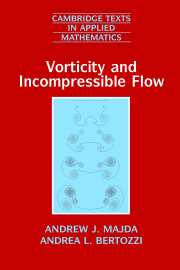Book contents
- Frontmatter
- Contents
- Preface
- 1 An Introduction to Vortex Dynamics for Incompressible Fluid Flows
- 2 The Vorticity-Stream Formulation of the Euler and the Navier-Stokes Equations
- 3 Energy Methods for the Euler and the Navier–Stokes Equations
- 4 The Particle-Trajectory Method for Existence and Uniqueness of Solutions to the Euler Equation
- 5 The Search for Singular Solutions to the 3D Euler Equations
- 6 Computational Vortex Methods
- 7 Simplified Asymptotic Equations for Slender Vortex Filaments
- 8 Weak Solutions to the 2D Euler Equations with Initial Vorticity in L∞
- 9 Introduction to Vortex Sheets, Weak Solutions, and Approximate-Solution Sequences for the Euler Equation
- 10 Weak Solutions and Solution Sequences in Two Dimensions
- 11 The 2D Euler Equation: Concentrations and Weak Solutions with Vortex-Sheet Initial Data
- 12 Reduced Hausdorff Dimension, Oscillations, and Measure-Valued Solutions of the Euler Equations in Two and Three Dimensions
- 13 The Vlasov–Poisson Equations as an Analogy to the Euler Equations for the Study of Weak Solutions
- Index
8 - Weak Solutions to the 2D Euler Equations with Initial Vorticity in L∞
Published online by Cambridge University Press: 03 February 2010
- Frontmatter
- Contents
- Preface
- 1 An Introduction to Vortex Dynamics for Incompressible Fluid Flows
- 2 The Vorticity-Stream Formulation of the Euler and the Navier-Stokes Equations
- 3 Energy Methods for the Euler and the Navier–Stokes Equations
- 4 The Particle-Trajectory Method for Existence and Uniqueness of Solutions to the Euler Equation
- 5 The Search for Singular Solutions to the 3D Euler Equations
- 6 Computational Vortex Methods
- 7 Simplified Asymptotic Equations for Slender Vortex Filaments
- 8 Weak Solutions to the 2D Euler Equations with Initial Vorticity in L∞
- 9 Introduction to Vortex Sheets, Weak Solutions, and Approximate-Solution Sequences for the Euler Equation
- 10 Weak Solutions and Solution Sequences in Two Dimensions
- 11 The 2D Euler Equation: Concentrations and Weak Solutions with Vortex-Sheet Initial Data
- 12 Reduced Hausdorff Dimension, Oscillations, and Measure-Valued Solutions of the Euler Equations in Two and Three Dimensions
- 13 The Vlasov–Poisson Equations as an Analogy to the Euler Equations for the Study of Weak Solutions
- Index
Summary
So far we have discussed classical smooth solutions to the Euler and the Navier–Stokes equations. In the first two chapters we discussed elementary properties of the equations and exact solutions, including some intuition for the difference between 2D and 3D and the role of vorticity. In Chaps. 3 and 4 we established the global existence of smooth solutions from smooth initial data in two dimensions (e.g., Corollary 3.3) and global existence in three dimensions, provided that the maximum of the vorticity is controlled (see, e.g., Theorem 3.6 for details). However, many physical problems possess localized, highly unstable structures whose complete dynamics cannot be described by a simple smooth model.
The remaining chapters of this book deal with mathematical issues related to non-smooth solutions of the Euler equations. This chapter addresses a type of weak solution appropriate for modeling an isolated region of intense vorticity, such as what one might use to model the evolution of a hurricane. In particular, we consider problems that have vorticity that is effectively discontinuous, exhibiting a strong eddylike motion in one region while being essentially irrotational in an adjacent region. To treat this problem mathematically, we must derive a formulation of the Euler equation that makes sense when the vorticity is discontinuous but bounded. We also assume that vorticity can be decomposed by means of a radial-energy decomposition (Definition 3.1) and in particular that it has a globally finite integral.
- Type
- Chapter
- Information
- Vorticity and Incompressible Flow , pp. 303 - 358Publisher: Cambridge University PressPrint publication year: 2001



